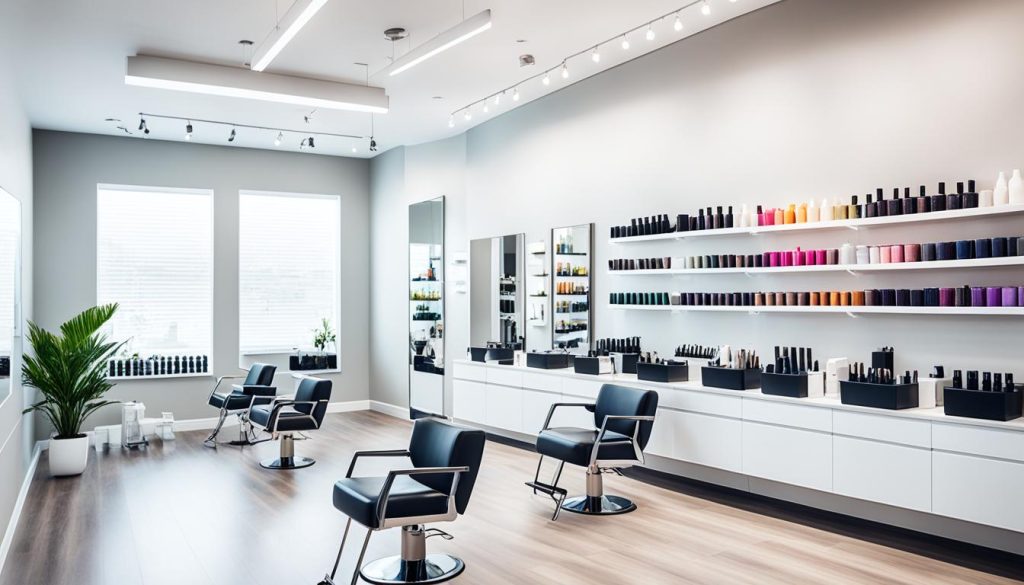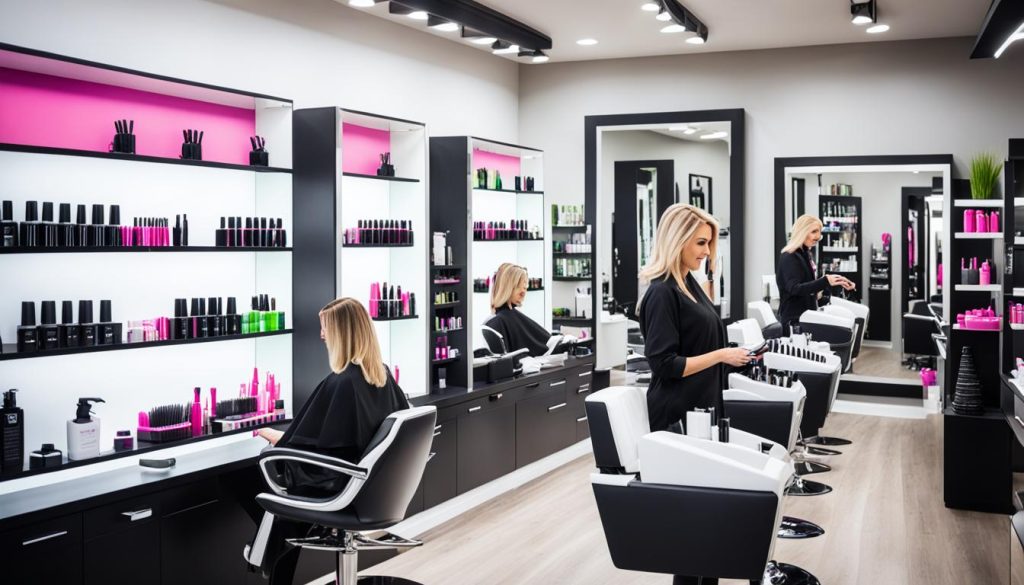Starting a hair salon can be an exciting and rewarding venture. However, it requires careful planning and execution to ensure long-term success. Whether you’re a seasoned hairstylist looking to take the next step or someone passionate about the beauty industry, this comprehensive guide will help you navigate the process of opening a hair salon with confidence.
If you’ve ever wondered how to start a hair salon, this article will cover the essential steps you need to take. From creating a hair salon business plan to understanding the legal requirements, finding the perfect location, and more, we’ve got you covered.
In this salon startup guide, we’ll break down each step and provide you with valuable insights and tips to help you kickstart your salon journey. Whether you’re just starting or already in the planning stages, this guide will serve as your roadmap to success.
How to Start a Hair Salon?
Understanding the Salon Industry
The salon and beauty industry can present challenges, but it also offers opportunities for growth and success. It is crucial to have a clear understanding of the dynamics of the salon industry to navigate the market effectively. By identifying potential challenges and exploring avenues for market expansion, salon owners can stay ahead of the competition and capitalize on emerging trends.
The Challenges of the Salon Industry
Operating a salon business comes with its fair share of challenges. Some common hurdles faced by salon owners include:
- Intense competition: With numerous salons in the market, standing out and attracting customers can be a significant challenge.
- High startup costs: Setting up a salon requires significant financial investment in equipment, supplies, and salon space.
- Legal obligations: Complying with licensing requirements, health and safety regulations, and other legal obligations can be complex.
- Location selection: Finding the perfect location that is accessible, visible, and fits within the budget can be a challenge.
Market Expansion Opportunities
Despite the challenges, the salon industry offers ample opportunities for market expansion. By adopting the right strategies, salon owners can tap into new target markets and attract a diverse range of customers. Some key factors to consider for market expansion include:
- Emerging trends: Stay updated on the latest beauty and salon trends to diversify service offerings and cater to evolving customer demands.
- Digital marketing: Utilize online platforms, social media, and targeted advertising to reach a wider audience and increase brand visibility.
- Expansion into beauty services: Consider offering additional beauty services such as facials, waxing, or manicures to attract a broader customer base.
- Collaborations and partnerships: Forge alliances with complementary businesses, such as fashion boutiques or wellness centers, to expand your reach and attract new customers.
To navigate the salon industry successfully, it is essential to stay informed about the challenges and opportunities it presents. By understanding these dynamics, salon owners can make informed decisions and develop strategies that drive growth and profitability.

| Challenges | Opportunities |
|---|---|
| Intense competition | Emerging trends |
| High startup costs | Digital marketing |
| Legal obligations | Expansion into beauty services |
| Location selection | Collaborations and partnerships |
Defining Your Salon Concept and Niche
When it comes to starting a hair salon, defining a unique and enticing salon concept and niche is crucial for standing out in the competitive beauty industry. Your salon concept reflects your vision and the experience you want to offer your clients. By carefully considering the services and treatments you will provide, you can attract your target audience and differentiate yourself from other salons.
Begin by exploring what aspect of hairdressing excites you the most. Is it creating stunning haircuts and styles, specializing in intricate hair color techniques, or focusing on luxurious spa treatments? Identifying your passion will not only help you create a salon experience that you genuinely enjoy but will also attract clients who share your enthusiasm.
To develop a tailored client experience, align your offerings with your salon theme. For example, if you aim to create a bohemian-inspired salon, consider offering natural and organic hair products, as well as services that promote a holistic approach to beauty. If your salon follows a modern and edgy aesthetic, explore trendy and innovative hair color techniques.
A crucial aspect of defining your salon concept and niche is providing in-demand beauty services. Stay informed about current beauty trends and popular services in the industry. This could include offering services such as balayage, keratin treatments, or eyebrow shaping and microblading.
Remember, your salon concept and niche should not only attract new clients but also foster customer loyalty. Offering specialized and high-quality beauty services will ensure that your clients keep coming back for more.

Crafting a Comprehensive Salon Business Plan
A well-crafted business plan is crucial for the success of your salon. It serves as a roadmap, guiding you through the various aspects of your salon’s development and growth. A salon business plan helps you analyze the market, understand your target audience, and make informed decisions based on financial projections.
Before diving into the details of your business plan, conduct thorough market research to gain valuable insights into the salon industry and identify trends and opportunities. Understand the needs and preferences of your target audience to tailor your salon offerings accordingly.
Market Research
Market research enables you to gather crucial information about your target market, competitors, and industry trends. It provides data-driven insights that can shape your salon’s strategy and positioning in the market.
When conducting market research for your salon business plan, consider the following:
- Analyze local competition: Identify other salons in your area and assess their strengths, weaknesses, and the services they offer. Determine how you can differentiate your salon and offer unique services.
- Identify target audience demographics: Understand the characteristics, preferences, and behaviors of your target customers. This information will help you tailor your salon’s services and marketing efforts to attract and retain your ideal clientele.
- Assess market demand: Investigate the demand for salon services in your area. Are there any gaps or unmet needs that your salon can fill?
- Evaluate industry trends: Stay updated on the latest industry trends, such as new treatments, technologies, and customer preferences. This will help you stay relevant and ahead of the competition.
Financial Projections
Financial projections are an essential part of your salon business plan. They demonstrate the viability and profitability of your salon concept, helping you secure financing and make informed decisions about pricing, expenses, and revenue expectations.
When creating financial projections for your salon business plan, consider the following:
- Start-up costs: Calculate the initial costs required to set up your salon, including equipment, salon furniture, supplies, and initial inventory.
- Fixed and variable expenses: Identify and estimate both fixed expenses, such as rent, utilities, and insurance, and variable expenses, including payroll, marketing, and product costs.
- Pricing strategy: Determine your pricing strategy based on your target market, competition, and desired profit margins. Ensure that your pricing is competitive while covering your expenses and generating profit.
- Revenue projections: Estimate your salon’s revenue based on the number of clients, pricing, and average spending per visit. Consider different scenarios, such as projected growth and seasonal fluctuations, to create realistic revenue projections.
Your salon business plan should also include a vision for the future of your salon. Outline your long-term goals, expansion plans, and strategies for attracting and retaining customers. Use your business plan as a guide throughout the planning process, continuously updating and revising it as your salon grows.
| Section | Description |
|---|---|
| Market Research | Analyze local competition, identify target audience demographics, assess market demand, evaluate industry trends |
| Financial Projections | Start-up costs, fixed and variable expenses, pricing strategy, revenue projections |

Legal Requirements and Documentation
Opening a salon requires adherence to various legal requirements and documentation. Familiarize yourself with the necessary steps to ensure a smooth and compliant salon operation.
Salon Licensing Requirements
Obtaining the appropriate licenses is a crucial step in starting your salon. Research and understand the specific licensing requirements for salons in your location. This may include licenses related to business operations, sanitation standards, and zoning regulations. Ensure that all licenses are obtained and prominently displayed within your salon.
Permits
In addition to licenses, certain permits may be required for specific salon services. For example, if you plan to offer nail extensions or tattooing, you may need separate permits from local authorities. Research and apply for the relevant permits to operate your preferred services legally.
Insurance
Securing comprehensive business insurance is essential to protect your salon and its assets. Consider policies that cover general liability, property damage, professional liability, and workers’ compensation. Consult with insurance providers to understand the coverage options that best suit your salon’s needs and mitigate potential risks.
Compliance with hygiene standards is paramount to ensure the health and safety of both staff and customers. Implement processes to maintain cleanliness and sanitation throughout your salon, including regular disinfection of tools and equipment, proper disposal of waste, and the use of sterilized tools for treatments.
Plan for health and fire marshal inspections to meet regulatory standards. Conduct regular self-assessments to address any potential issues before official inspections occur. It’s important to prioritize a safe and secure environment for both your team and clients.

| Legal Requirement | Description |
|---|---|
| Business Licenses | Obtain the necessary licenses to operate legally. |
| Permits | Apply for specific permits related to salon services. |
| Insurance | Secure comprehensive business insurance to protect assets. |
Finding the Perfect Location
When opening a hair salon, choosing the right location is paramount to your success. Consider several factors to ensure your salon thrives in its chosen location. Begin by assessing the availability of parking spaces near the salon. Adequate parking is essential for ensuring convenience for your clients and attracting new ones who may be deterred by parking-related challenges.
Additionally, consider the potential for advertising in the chosen location. A salon located in a high-traffic area or near popular shops and malls offers excellent advertising opportunities. The visibility of your salon to passersby can significantly impact your footfall, and ultimately, your clientele. Prioritize locations with high visibility and foot traffic for optimal exposure.
Proximity to other businesses and amenities is another crucial aspect to consider. A salon located near complementary businesses like beauty supply stores or fashion boutiques can benefit from synergistic relationships and potential referrals. Furthermore, being in proximity to residential areas ensures convenience for your clients, making it easier for them to schedule appointments and frequent your salon regularly.
Finally, don’t overlook the importance of suitable plumbing for salon operations. Ensure the chosen location has the necessary plumbing infrastructure to accommodate your salon’s specific needs, such as water supply, drainage, and ventilation. Investing in a location with existing plumbing systems in good condition can save you time, effort, and expenses associated with plumbing renovations.





